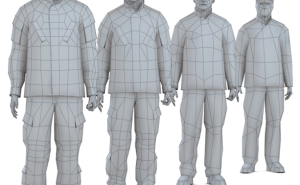
The Impact of Level of Detail Systems on Rendering Efficiency in Unity
In this article, we will be discussing the fundamentals of LOD (Level of Detail) systems and their role in rendering efficiency within Unity. We’ll also be exploring how LOD impacts performance metrics. By the end, you should have a better understanding of how LOD can optimize your rendering processes.
The Basics of LOD Systems
LOD is a game design technique that revolves around the idea of adjusting an object’s complexity based on its distance from the camera. In simpler terms, the farther an object is from the player’s viewpoint, the lower its level of detail, and vice versa. By presenting objects with reduced complexity when they are distant, LOD helps reduce the rendering workload and eases the strain on your device’s resources.
Unity’s LOD systems are ingeniously designed to handle this process seamlessly. When you implement LOD, you create multiple versions of an asset with varying levels of detail. As an object moves closer to or farther from the camera, Unity dynamically switches between these versions, ensuring that only the appropriate level of detail is displayed. This smart transition is nearly unnoticeable to players but significantly contributes to rendering efficiency.
Now, let’s talk about the real perks of using LOD in your projects:
Smoother Gameplay: By reducing the level of detail on distant objects, LOD significantly improves frame rates, resulting in smoother and more enjoyable gameplay experiences.
Lower Memory Consumption: With LOD in action, your game consumes less memory since only necessary details are loaded, making it easier to run on a variety of devices.
Faster Rendering: LOD systems lighten the rendering burden on your CPU and GPU, allowing them to focus on other essential tasks and further enhancing your game’s performance.
Scalability: LOD ensures that your game scales gracefully across different hardware configurations, enabling you to reach a broader audience.
Rendering Efficiency in Unity

In the realm of game development, rendering reigns supreme as the art of bringing your game’s world to life. Unity’s powerful rendering pipeline orchestrates a symphony of geometric processing, lighting, shading, and texture mapping, crafting mesmerizing scenes that engulf players in their virtual reality.
Yet, the crux lies in rendering efficiency. Every millisecond matters in the fast-paced gaming universe. Smooth gameplay, fostered by efficient rendering, cultivates player engagement, retention, and glowing reviews, especially on modest hardware setups.
Resource-intensive scenes pose challenges with 3D complexity, high-res textures, dynamic lighting, and particle systems. As your game evolves, these hurdles amplify, demanding optimization for peak performance.
Taming these obstacles requires finesse. Implementing Level of Detail (LOD) systems cleverly reduces rendering load by adjusting object detail based on distance. Embracing occlusion culling hides unseen objects, further elevating performance.
Understanding the Role of LOD in Rendering Efficiency
LOD works by dynamically adjusting the level of detail displayed based on the distance between the camera and the objects in the scene. When objects are far away, a lower-detail version is rendered, significantly reducing the rendering workload. This means that your GPU doesn’t waste resources on rendering intricate details that players might not even notice at a distance.
Unity offers various LOD techniques to suit different game scenarios. One of the most commonly used approaches is the “LOD Group” component. By organizing assets into LOD groups, you can create different versions of an object with decreasing levels of detail. Additionally, Unity’s Shader LOD system can adjust the complexity of shaders based on the distance from the camera, further optimizing rendering performance.
To grasp the real impact of LOD on rendering efficiency, let’s look at a practical example. Imagine you have a sprawling open-world environment with dense forests, mountains, and distant landscapes. Without LOD, rendering all the intricate details of trees and foliage in the distance could lead to a massive performance hit.
However, by implementing LOD for your environment assets, you can ensure that as the player moves away from certain areas, the distant trees and mountains transition into lower-polygon versions, easing the rendering burden on the GPU. This results in a smoother gameplay experience, even on lower-end hardware.
Impact of LOD on Performance Metrics
Smooth and consistent frame rates are crucial for player immersion. LOD systems dynamically adjust the level of detail displayed based on the player’s proximity to objects. This means that distant or less critical objects are rendered with fewer polygons and textures, resulting in faster rendering times. As a result, frame rates are improved, and those annoying lags are substantially reduced.
In the realm of resource-intensive scenes, where memory resources are a scarce treasure, the valiant LOD comes to the rescue! By optimizing memory consumption through lower-resolution textures and simpler models for distant objects, your game triumphantly saves memory overhead. Moreover, LOD’s brilliant texture streaming ensures that only vital textures are loaded, further reducing memory demands and liberating valuable resources.
As honorable developers, we embark on a quest to captivate a diverse audience, encompassing players with varying hardware capabilities. LOD, a steadfast companion, plays a crucial role by allowing your game to scale across different devices gracefully. Even on low-end hardware, players can partake in your game, albeit with reduced visual complexity. Meanwhile, those fortunate enough to wield powerful rigs will be astonished by the awe-inspiring details up close.
Conclusion
Level of Detail (LOD) systems in Unity wield a profound influence on rendering efficiency. By strategically managing asset complexity based on distance, LOD significantly improves performance metrics like frame rates, memory consumption, and overall gameplay smoothness. As developers, integrating LOD systems into our projects is a vital step toward optimizing game performance and creating more immersive experiences for players. Embrace LOD, strike the right balance between visual quality and efficiency, and watch your Unity games thrive with seamless rendering.e
Featured Image Credit. From the docs.unity3d.com sit; Thank you!




